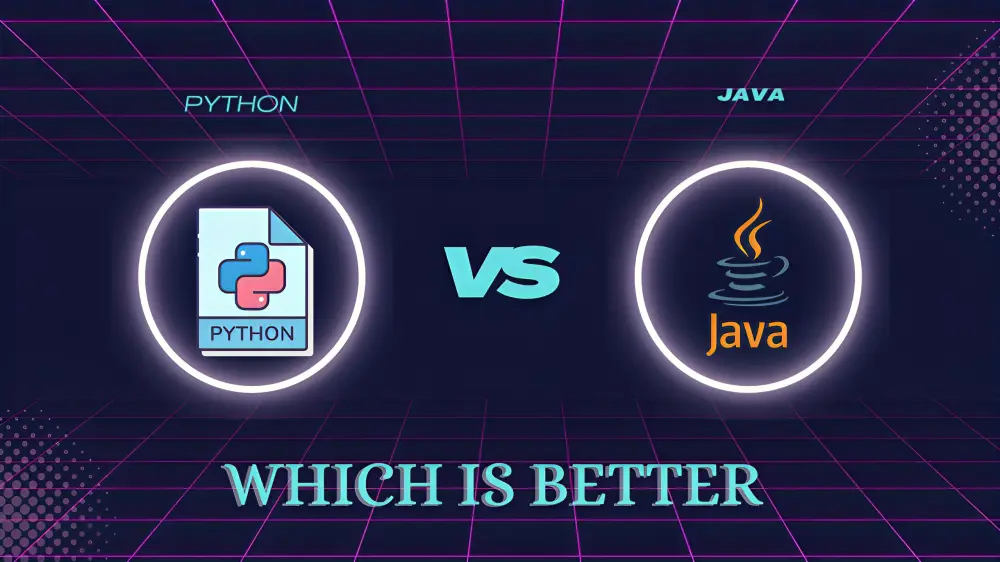Two of the most influential programming languages are Python and Java. Both have their advantages and disadvantages despite being extensively used, adaptable, and strong. Deciding between them can be difficult, particularly for those who are new to the field of software development. So let’s examine the differences between Python vs Java in more detail to see which one would be a better fit for your upcoming project.
Python vs Java: Key Statistics
| Metric | Python | Java |
| Stack Overflow Developer Survey 2023 | 51.52% (↑) | 32.44% (↓) |
| SlashData Developer Survey 2022 | 45.14% (↑) | 32.17% (↓) |
| Indeed.com Job Listings | 205,332 (↑) | 167,521 (↓) |
| LinkedIn Job Listings | 2,648,015 (↑) | 4,323,580 (↓) |
| W3Techs Market Share | 1.2% (↑) | 5.3% (↓) |
| Tech Market Share | 54.87% (↑) | 24.16% (↓) |
| GitHub Repositories | 102.5 million (↑) | 81.7 million (↑) |
| Google Search Interest | Steady ↑ | Slight ↓ |
| Average Salary (US) | $107,500 (↑) | $112,000 (↑) |
| Learning Curve | Easier | Steeper but valuable |
What is Python?
A general-purpose programming language with dynamic typing is called Python. Early Python development happened at a research institute in the Netherlands. It has an easy-to-read syntax. Inspired by Pascal, ABC, and Algol68, the syntax was created. Python is a good choice for Rapid Application Development because of its built-in data structures with dynamic typing, binding, and low maintenance costs. Python has the benefit of having a freely available resource library and interpreter on the Internet.
Advantages of Python
- Python is widely used in IoT.
- extensive developer tools and libraries.
- Auto-installed and cross-compatible shell.
- Development tasks are made easier by prebuilt libraries.
- Python’s syntax is simpler than that of Java, C, and C++.
- utilized in data analysis, AI, machine learning, and visualization.
- provides database interfaces for the most popular DBMS systems.
- Runs on a variety of platforms and operating systems and is portable.
- Compared to other languages, it is simple to write, debug, and maintain.
- simplifies complex programming by handling memory and garbage collection.
What is Java?
Java is a concurrent, object-oriented, statically typed, general-purpose programming language. Java was created to be a WORA (write once, run everywhere) language that could run on any platform with the fewest possible dependencies thanks to the Java Virtual Machine (JVM).
Advantages of Java
- Outstanding work.
- straightforward libraries.
- A vast collection of third-party libraries.
- forms reusable code and standard programs.
- There is thorough documentation available for Java.
- There’s a big talent pool of experienced developers.
- environment with multiple threads for concurrent tasks.
Python vs Java Differences by Functionality
- Memory Use: Because of JVM overhead, Java consumes more memory. Python uses less memory overall but starts up more slowly. Python code is optimized by libraries like PyPy, resulting in 2-4 times less memory usage.
- Type Safety: Python is dynamically typed, whereas Java is statically typed. To prevent errors during compilation, Java code must strictly declare variables and function return types. Python is more adaptable; type changes can be made at runtime; however, errors can only occur while the program is running.
- Speed: Because of the JVM’s just-in-time optimization and intermediate bytecode compilation, Java code executes more quickly. Due to some overhead caused by Python’s dynamic nature, Java is over 2.5 times faster according to benchmarks. However rapid progress in Python interpreters is narrowing the difference.
- Concurrency: Java’s multi-threaded architecture makes it easier to write parallel, asynchronous applications. Python was designed to run one thread at a time with a GIL lock. Python can now efficiently run async/parallel code across multiple CPU cores thanks to recent advancements.
Which has a Better Future Python vs Java?
- Studies show that 2.5 times as many novice programmers begin with Python as with Java, suggesting a potential shift in developer mindset.
- The use of Python packages has surged in the cloud and open-source communities, providing developers with a wealth of ready code.
- Python is a good choice for agile environments due to its concise syntax and low learning curve, which enable faster application development times.
- Python has an advantage going forward because it dominates important areas of technology growth like web development, DevOps, machine learning, and data science.
- Enterprise adoption of Python is fueled by high-level Python libraries such as TensorFlow, OpenCV, and NumPy, as well as automation tools like Ansible and Airflow.
- For Python development, all of the main cloud providers—AWS, Azure, and GCP—offer managed services and first-rate support.
Which is More Effective for the Future?
Python’s rapid adoption in enterprises, forays into new markets like edge computing on the Internet of Things, and maintains its position as the top AI programming language. Its ability to scale performance-wise using frameworks like TensorFlow, PyTorch, Ray, and Dask as well as libraries like Numba Rust Python, along with its simple syntax, are what have made Python popular among programmers. Though it might eventually slow down, Python’s growth is still unrivaled.
Java continues to be the most popular backend language and powers the majority of Fortune 500s. Plenty of opportunities are guaranteed by the significance of fundamental Java EE technologies like the Spring ecosystem, the expanding use of frameworks like Micronaut and Quarkus for cloud-native development, and the ongoing relevance of Big Data/Fast Data analytics. Even though its growth has stopped, Java is still essential for intricate business systems.
Python is preferred by developers because it has a lower learning curve and therefore a wider pool of competent candidates. However, according to PayScale and Indeed surveys, Java developers continue to earn higher average salaries, reflecting their combined programming and architect-level skills.
Conclusion
Both Python vs Java have advantages and disadvantages in the current debate, making the decision difficult. Python’s ease of use, adaptability in data science and AI, and quick uptake portend a bright future. In the meantime, Java’s strong documentation, ability to multithread, and established place in enterprise systems guarantee that it will remain relevant.





